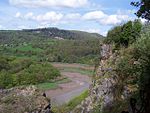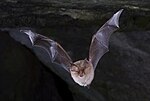Lower Wye Gorge SSSI
Forests and woodlands of GloucestershireNature reserves in GloucestershireRiver WyeSites of Special Scientific Interest in GloucestershireSites of Special Scientific Interest notified in 1954 ... and 2 more
TidenhamUse British English from July 2014
Lower Wye Gorge (grid reference ST548983, ST537967) is a 65-hectare (160-acre) biological and geological Site of Special Scientific Interest in Gloucestershire, notified in 1954 and renotified 1987. The site includes two Gloucestershire Wildlife Trust nature reserves being Ban-y-gor Wood and Lancaut. The Natural England citation states a revision for Lancaut inclusion.The site (Lancaut and Ban-y-gor) is listed in the 'Forest of Dean Local Plan Review' as a Key Wildlife Site (KWS).Wye Valley Woodlands/ Coetiroedd Dyffryn Gwy are recognised as a Special Area of Conservation (SAC) under the EU Habitats Directive.
Excerpt from the Wikipedia article Lower Wye Gorge SSSI (License: CC BY-SA 3.0, Authors).Lower Wye Gorge SSSI
Lancaut Walk, Forest of Dean Tidenham
Geographical coordinates (GPS) Address Nearby Places Show on map
Geographical coordinates (GPS)
| Latitude | Longitude |
|---|---|
| N 51.666 ° | E -2.666 ° |
Address
Lancaut Walk
Lancaut Walk
NP16 7JP Forest of Dean, Tidenham
England, United Kingdom
Open on Google Maps









